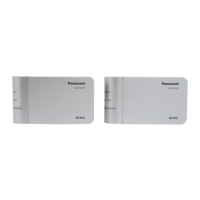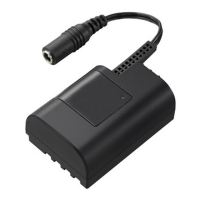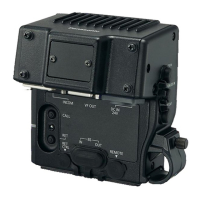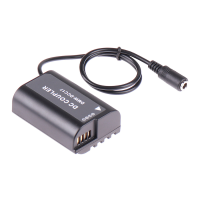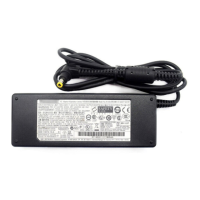Operating Instructions
Manuel d’utilisation
Instrucciones de funcionamiento
Wireless Adaptor for VIERA
Adaptateur sans fi l pour VIERA
Adaptador Inalámbrico para VIERA
Model No. TY-WL20U
Modèle TY-WL20U
Modelo No. TY-WL20U
Panasonic Consumer Marketing Company of North America
Division of Panasonic Corporation of North America
One Panasonic Way Secaucus, New Jersey 07094
http://www.panasonic.com
Panasonic Canada Inc.
5770 Ambler Drive, Mississauga, Ontario L4W 2T3
www.panasonic.ca
© Panasonic Corporation 2012
Printed in China
Imprimé en Chine
Impreso en China
TQZJ422
S1211-0
ENGLISH
Dear customer
Thank you for purchasing this product.
For optimum performance and safety, please read these instructions carefully.
Before connecting, operating or adjusting this product, please read the instructions
completely.
Please keep this manual for future reference.
This Wireless Adaptor for VIERA is intended only
for use with Panasonic wireless LAN-compatible
televisions, which are scheduled to go on sale from
2012.
● For how to connect or use this Wireless Adaptor for VIERA
Please refer to the respective operating instructions.
● For information on TV models confi rmed for use with this Wireless
Adaptor for VIERA
Please refer to the Panasonic website.
http://panasonic.jp/support/global/cs/
(This site is in English only.)
Accessory
1 USB extension cable (K2KYYYY00150)
● Always use this cable when connecting a TV.
● Do not use any other USB extension cables except the supplied one.
● Product numbers correct as of December 2011. These may be subject to change.
● To order accessories, call the dealer from whom you have made your purchase.
FRANÇAIS
Cher client
Nous vous remercions d’avoir arrêté votre choix sur cet appareil.
Pour en tirer un rendement optimal, lire attentivement le présent manuel.
Avant de raccorder, régler ou d’utiliser l’appareil, il est recommandé de lire attentivement le
manuel d’utilisation. Conserver ce manuel.
Cet adaptateur sans fi l pour VIERA est seulement
conçu pour utilisation avec les téléviseurs Panasonic
compatibles avec un réseau local sans fi l, qui seront
disponibles en 2012.
● Pour les instructions sur le raccordement ou utilisation de cet adaptateur
sans fi l pour VIERA
Veuillez vous reporter aux manuels d’utilisation des appareils respectifs.
● Pour les informations concernant les modèles de téléviseur pouvant être
utilisés avec cet adaptateur sans fi l pour VIERA
Veuillez vous reporter au site Web global de Panasonic.
http://panasonic.jp/support/global/cs/
(En anglais seulement.)
Accessoires
1 Câble prolongateur USB (K2KYYYY00150)
● Toujours utiliser ce câble lors de connexion avec un téléviseur.
● N’utilisez pas d’autres câbles prolongateurs USB à l’exception de celui fourni.
● Les numéros de modèle sont à jour depuis décembre 2011. Ces numéros peuvent être modifi és
sans préavis.
● Pour la commande d’accessoires, contactez le détaillant où l’appareil a été acheté.
ESPAÑOL
Estimado cliente
Gracias por comprar este producto.
Para un rendimiento óptimo y por seguridad lea atentamente estas instrucciones.
Antes de conectar, operar o ajustar este producto, lea completamente las instrucciones.
Guarde este manual para referencia futura.
Este Adaptador Inalámbrico para VIERA tiene como fi n
su uso sólo con televisores Panasonic compatibles
con LAN inalámbricas programadas para ser
comercializadas a partir de 2012.
● Sobre cómo conectar o utilizar el Adaptador Inalámbrico para VIERA
Consulte las instrucciones operativas correspondientes.
● Para información sobre modelos de TV confi rmados para utilizar con el
Adaptador Inalámbrico para VIERA
Consulte el sitio Web de Panasonic.
http://panasonic.jp/support/global/cs/
(Este sitio está solamente en idioma inglés.)
Accesorios
1 Cable de extensión USB (K2KYYYY00150)
● Utilice siempre este cable al conectar la TV.
● No utilice ningún otro cable de extensión USB excepto el suministrado.
● Los números de producto son correctos a diciembre de 2011. Pueden estar sujetos a cambios.
● Para realizar pedidos de accesorios, llame al comerciante al que le realizó su compra.
(continúa al dorso)
THE FOLLOWING APPLIES IN THE U.S.A. AND CANADA
This device complies with Part 15 of FCC Rules and RSS-Gen of IC Rules.
Operation is subject to the following two conditions:
(1) This device may not cause interference, and (2) this device must accept any interference, including interference that
may cause undesired operation of this device.
This transmitter must not be co-located or operated in conjunction with any other antenna or transmitter.
This product is restricted to indoor use due to its operation in the 5.15 to 5.25 GHz frequency range.
FCC and IC require this product to be used indoors for the frequency range 5.15 to 5.25 GHz to reduce the potential for
harmful interference to co-channel Mobile Satellite systems, High power radars and allocated as primary users of the 5.25
to 5.35 GHz and 5.65 to 5.85 GHz bands. These radar stations can cause interference with and/or damage this product.
The available scientifi c evidence does not show that any health problems are associated with using low power wireless
devices. There is no proof, however, that these low power wireless devices are absolutely safe.
Low power Wireless devices emit low levels of radio frequency energy (RF) in the microwave range while being used.
Whereas high levels of RF can produce health effects (by heating tissue), exposure to low-level RF that does not
produce heating effects causes no known adverse health effects.
Many studies of low-level RF exposures have not found any biological effects. Some studies have suggested that some
biological effects might occur, but such fi ndings have not been confi rmed by additional research.
Wireless Adaptor for VIERA (TY-WL20U) has been tested and found to comply with FCC/IC radiation exposure limits set
forth for an uncontrolled equipment and meets the FCC radio frequency (RF) Exposure Guidelines in Supplement C to
OET65 and RSS-102 of the IC radio frequency (RF) Exposure rules.
THE FOLLOWING APPLIES ONLY IN THE U.S.A
FCC Note:
This equipment has been tested and found to comply with the limits for a Class B digital device, pursuant to Part 15 of
the FCC Rules.
These limits are designed to provide reasonable protection against harmful interference in a residential installation. This
equipment generates, uses and can radiate radio frequency energy and, if not installed and used in accordance with the
instructions, may cause harmful interference to radio communications.
However, there is no guarantee that interference will not occur in a particular installation. If this equipment does cause
harmful interference to radio or television reception, which can be determined by turning the equipment off and on, the
user is encouraged to try to correct the interference by one or more of the following measures:
● Reorient or relocate the receiving antenna.
● Increase the separation between the equipment and receiver.
● Connect the equipment into an outlet on a circuit different from that to which the receiver is connected.
● Consult the dealer or an experienced radio/TV technician for help.
FCC caution: To maintain compliance with FCC regulations, shielded interface cables must be used with this equipment.
Operation with non-approved equipment or unshielded cables may result in interference to radio and TV reception. Any
changes or modifi cations not approved by the party responsible for compliance could void the user’s authority to operate
this equipment.
This device complies with Part 15 of the FCC Rules. Operation is subject to the following two conditions:
(1) This device may not cause harmful interference, and
(2) this device must accept any interference received, including interference that may cause undesired operation.
Responsible Party:
Panasonic Corporation of North America
One Panasonic Way
Secaucus, NJ 07094
Support Contact:
Panasonic Consumer Marketing Company of North America
Telephone No: 1-800-211-PANA (7262)
THE FOLLOWING APPLIES ONLY IN CANADA
This Class B digital apparatus complies with Canadian ICES-003.
Product Identifi cation Marking is located on the bottom of the unit.
When this unit is not recognized
Messages such as “No Adaptor” or “Device Error” is displayed.
● Check if this unit is inserted fully and securely.
● Try removing this unit once, and inserting it again.
If it does not get recognized even after performing the above, consult the dealer where you purchased
this unit.
CE QUI SUIT S’APPLIQUE AU CANADA ET AUX ÉTATS-UNIS
Cet appareil est conforme à la section 15 de la réglementation de la FCC et à la section RSS-Gen de la réglementation
IC. Son utilisation est soumise aux deux conditions suivantes : (1) cet appareil ne doit pas provoquer d’interférence et (2)
cet appareil doit tolérer les différentes interférences reçues, y compris les interférences susceptibles de provoquer un
dysfonctionnement.
Cet émetteur ne doit pas être placé à proximité d’une autre antenne ou d’un autre émetteur, ni être utilisé de pair avec
de tels autres appareils.
Ce produit est strictement destiné à un usage en intérieur en raison de son fonctionnement dans la bande passante
de fréquence 5,15 à 5,25 GHz. La FCC et IC exigent que ce produit soit utilisé à l’intérieur à une plage de fréquence
variant de 5,15 à 5,25 GHz pour réduire la possibilité d’interférences nocives aux systèmes satellites mobiles dans un
même canal. Les radars haute puissance sont désignés comme utilisateurs principaux des bandes 5,25 à 5,35 GHz et
5,65 à 5,85 GHz. Ces stations radars peuvent causer des interférences et (ou) endommager l’appareil.
Les connaissances scientifi ques disponibles ne font état d’aucun problème de santé associé à l’utilisation d’appareils
sans fi l à faible puissance. Par contre, il n’existe aucune preuve que ces appareils ne posent absolument aucun risque
pour la santé. Les appareils sans fi l de faible puissance émettent de bas niveaux d’énergie radiofréquence (RF) dans la
plage des micro-ondes pendant leur utilisation.
Bien que des niveaux élevés de RF puissent avoir des effets nocifs sur la santé (en faisant augmenter la température
des tissus), l’exposition à de bas niveaux de RF n’entraînant aucun effet thermique ne pose aucun risque connu à la
santé. Les nombreuses études portant sur les expositions RF de faible intensité n’ont décelé aucun effet biologique.
Certaines études ont suggéré l’existence de certains effets biologiques, mais leurs conclusions n’ont pas été
corroborées.
L’adaptateur sans fi l pour VIERA (TY-WL20U) est conforme aux limites d’exposition aux radiofréquences FCC/
IC établies pour un environnement non contrôlé et satisfait aux exigences de conformité pour l’exposition aux
radiofréquences (RF) de la FCC, Supplément C à OET65 et RSS-102 des exigences d’exposition aux RF de l’IC.
CE QUI SUIT NE S’APPLIQUE QU’AU CANADA
Cet appareil numérique de la classe B est conforme à la norme NMB-003 du Canada.
La plaque signalétique se trouve sur le dessous de l’appareil.
Lorsque cet adaptateur n’est pas reconnu
Les messages tels que « Aucun adaptateur » ou « Erreur de l’appareil » sont affi chés :
● vérifi ez que l’adaptateur soit bien inséré à fond et de façon sécuritaire ;
● ressayez en retirant l’adaptateur et en l’insérant de nouveau.
Si l’adaptateur n’est toujours pas reconnu, consultez le détaillant où l’appareil a été acheté.
Precautions
The following limits are in place regarding the usage of this device. You must be aware of these limits
before using this device.
Panasonic will in no way be responsible for any incidental damage which may arise due to a failure to
obey these limits, or to any condition of use or disuse of this device.
● This device is to be used as a wireless LAN device.
● Do not use this device to connect to any wireless network for which you do not have usage
rights.
During automatic searches in a wireless network environment, wireless networks (SSID*) for which
you do not have usage rights may be displayed; however, using these networks may be regarded
as illegal access.
* An SSID (Service Set IDentifi cation) is a name used by wireless LAN to identify a particular
network. Transmission is possible if the SSID matches for both devices.
● Data transmitted and received over radio waves may be intercepted and monitored.
● If you have an 802.11n (compatible with 2.4 GHz and 5 GHz) wireless broadband router
(access point), we recommend using it at 5 GHz.
● Confi gure the appropriate security settings (encryption settings). For details, see the
instructions of your access point.
To Prevent Malfunctions
This device contains precision electronic components.
Use the device correctly while being careful of the following.
● Avoid using in high temperatures or direct sunlight.
● Do not bend or expose to strong impacts.
● Do not expose to water.
● Do not disassemble or modify.
● Do not connect to devices other than supported devices.
During Operation
Parts of the wireless adaptor body may become hot.
● The temperature of the plastic case may rise, but this will not affect performance or quality.
Pour éviter les dysfonctionnements
Cet appareil contient des composants électroniques de précision.
Utilisez l’appareil correctement tout en faisant attention aux aspects suivants :
● Évitez d’utiliser l’appareil lorsque la température est élevée ou directement au soleil.
● Ne pliez pas l’appareil et évitez les impacts.
● N’exposez pas l’appareil à l’eau.
● Ne désassemblez et ne modifi ez pas l’appareil.
● Ne connectez pas l’appareil à d’autres appareils que ceux pris en charge.
Pendant le fonctionnement
Des parties du corps de l’adaptateur sans fi l peuvent devenir chaudes.
● La température du boîtier de plastique peut augmenter, mais cela n’affectera pas la
performance ou la qualité.
Précautions
Les limites suivantes ont été établies quant à l’usage de cet appareil. Vous devez connaître ces
limites avant d’utiliser cet appareil.
Panasonic n’assume aucune responsabilité pour tout dommage pouvant être causé par l’omission du
respect de ces limites ou toute autre condition d’usage ou l’abandon de cet appareil.
● Cet appareil doit être utilisé en tant qu’appareil de réseau local sans fi l.
● Ne pas utiliser cet appareil pour la connexion à un réseau sans fi l pour lequel vous ne
détenez pas de droits d’usage.
Au cours du processus de recherché automatique dans un environnement de réseau sans fi l, il
peut arriver que des réseaux sans fi l (SSID*) pour lesquels vous ne détenez pas de droits d’usage
soient affi chés ; or, l’utilisation de tels réseaux pourrait être considérée comme relevant d’un accès
illégal.
* Un identifi ant de réseau sans fi l (Service Set IDentifi cation - SSID) est un nom utilisé par un
réseau local sans fi l pour identifi er un réseau donné. La transmission est possible lorsque le
SSID des deux appareils est le même.
● Les données émises et reçues par ondes radio peuvent être interceptées et surveillées.
● Si vous avez un routeur sans fi l (point d’accès) 802.11n (2,4 GHz et 5 GHz), nous
recommandons l’utilisation à 5 GHz.
● Confi gurer les réglages de sécurité appropriés (réglages de cryptage). Pour plus de détails,
se référer aux instructions de votre point d’accès.
(continued overleaf)
(suite au verso)
TY-WL20UOI.indd1TY-WL20UOI.indd1 2012/01/0616:39:182012/01/0616:39:18

